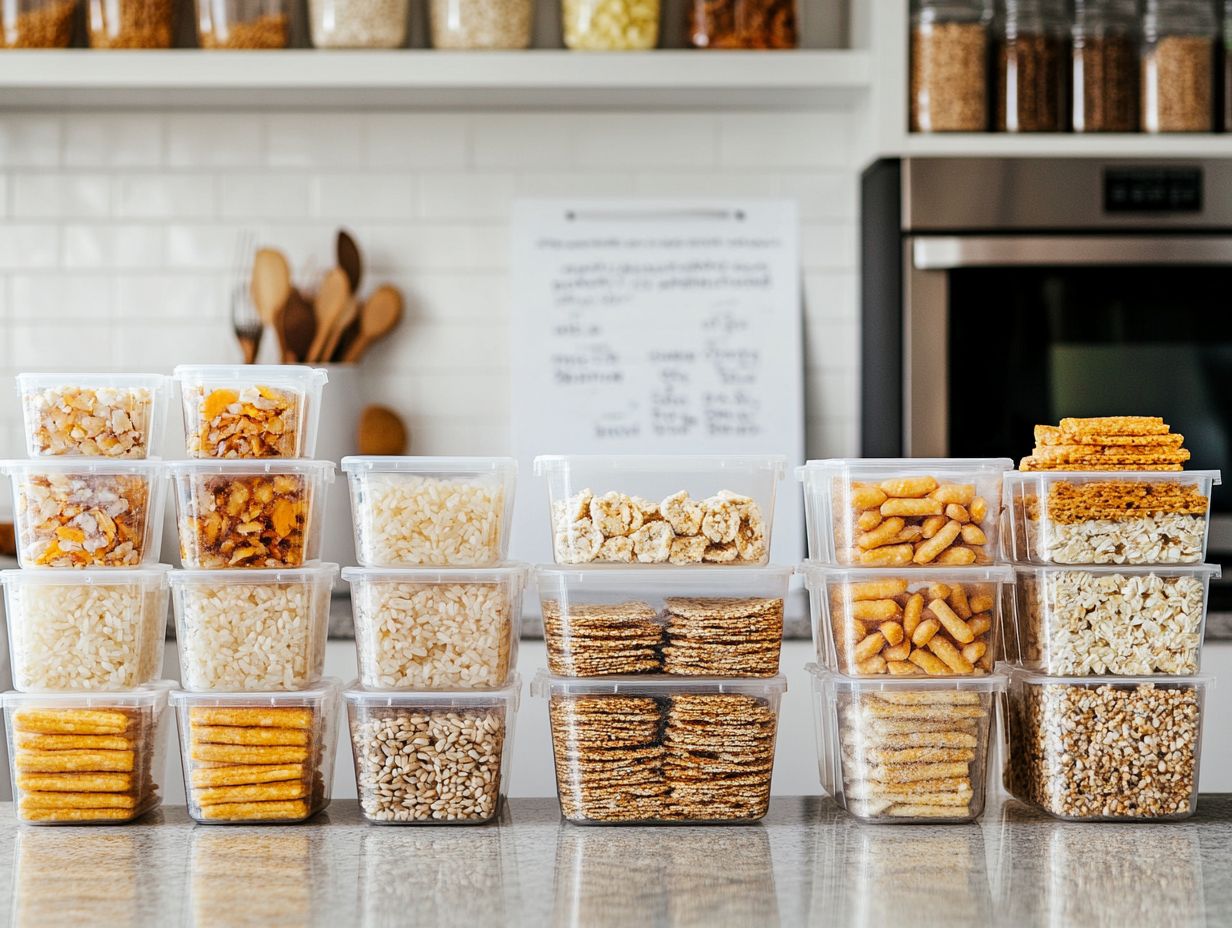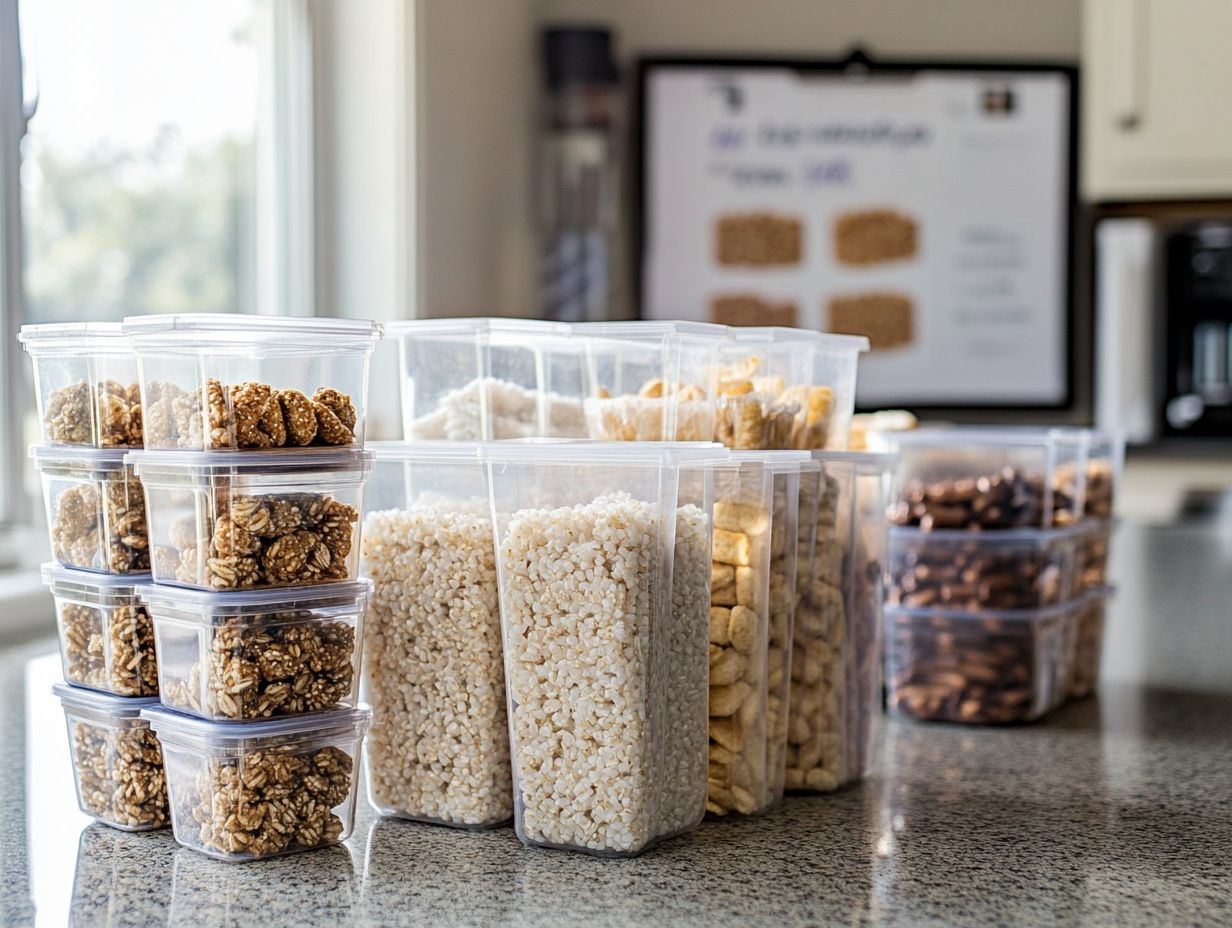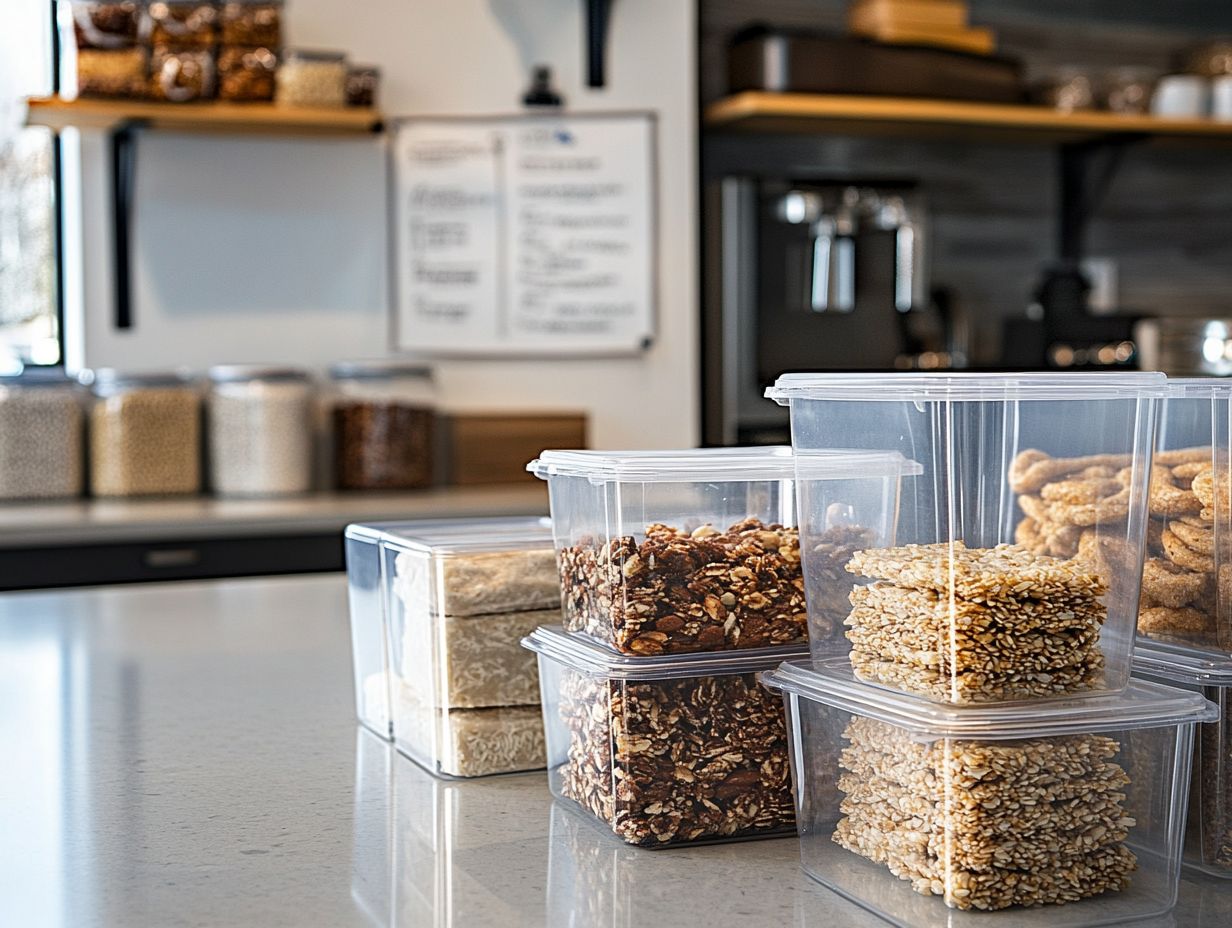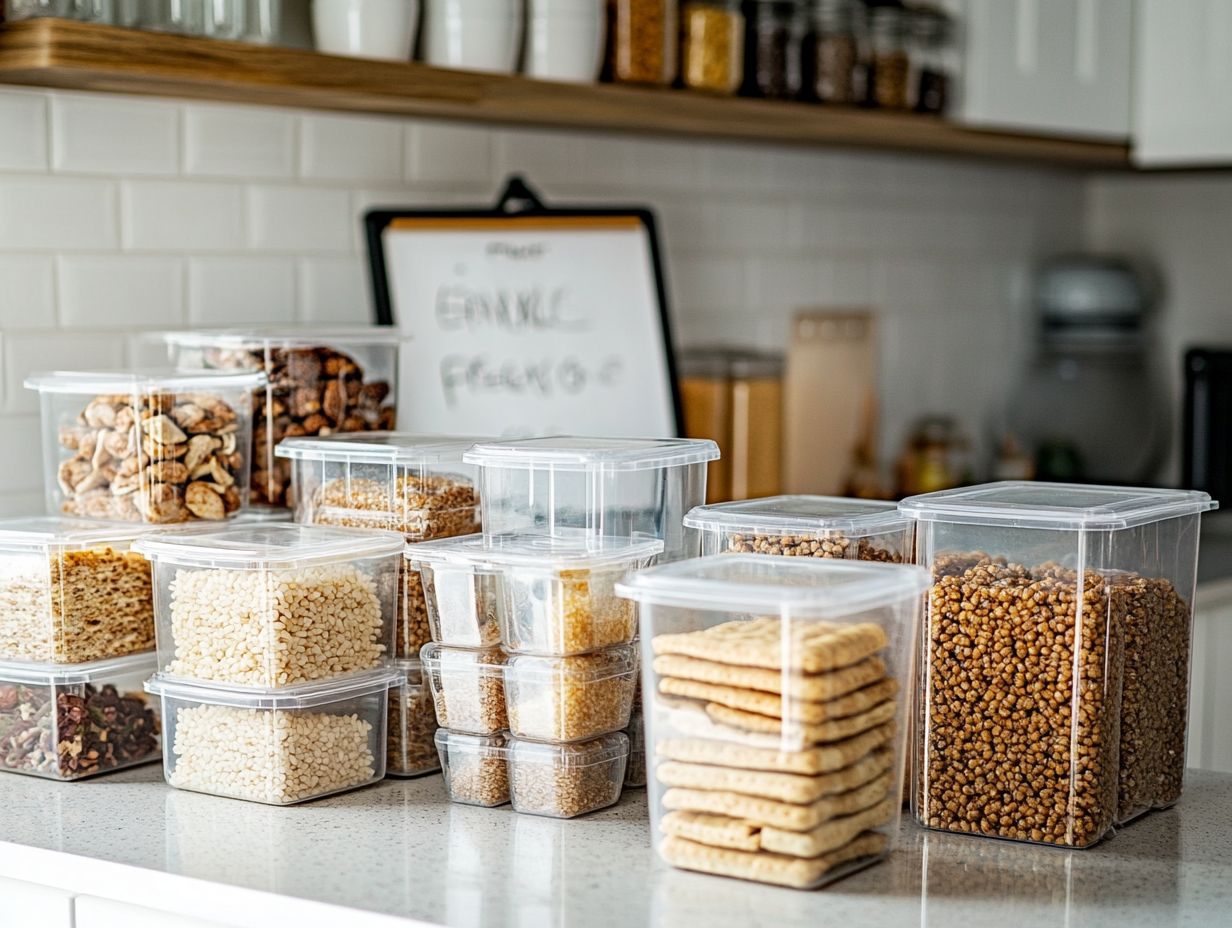How to Store Gluten-Free Snacks Properly?
Contents
- How to Store Gluten-Free Snacks Properly
- What are the Signs of Spoiled Gluten-Free Snacks?
- How Can You Tell if a Gluten-Free Snack is Safe to Eat?
- Frequently Asked Questions
- What is the best way to store gluten-free snacks?
- Can I store gluten-free snacks in the fridge or freezer?
- How long can I store gluten-free snacks?
- Do I need to keep gluten-free snacks separate from other snacks?
- Can I reseal opened gluten-free snack packages?
- What should I do if my gluten-free snacks become stale or spoiled?
How to Store Gluten-Free Snacks Properly
Gluten-free snacks offer a delightful and essential choice for individuals with gluten sensitivities or celiac disease. Ensuring proper storage is vital for maintaining their freshness and safety.
This article delves into what gluten-free snacks truly are and the importance of proper storage. It also covers the best techniques to keep them tasting their best. Additionally, it highlights the signs of spoilage and provides guidance on how to ensure your snacks remain safe to enjoy.
Get ready to discover the ultimate gluten-free snacking experience filled with delicious options!
Key Takeaways:

- Proper food storage is crucial for maintaining the quality and safety of gluten-free snacks.
- Airtight containers, cool and dry places, and freezing are effective ways to store gluten-free snacks, including healthy options like quinoa snacks and flavored popcorn.
- Check for changes in texture, unpleasant odors, and mold growth to determine if a gluten-free snack is spoiled. Always check the expiration date before indulging! Consulting a nutritional coaching expert can also offer additional tips for ensuring your snacks are safe to eat.
What are Gluten-Free Snacks?
Gluten-free snacks are meticulously crafted foods designed for individuals with gluten intolerance and celiac disease. These snacks feature organic ingredients and sweeteners. They cater to a gluten-free diet while ensuring enjoyment and safety.
You ll find an array of savory selections, like Artisan Tropic s cassava chips, Plantain chips, and XoChitl tortilla chips. Sweet delights include Savor By Suzie s cookies, Clio Greek Yogurt Bars, and Choomies macaroons.
The spectrum of gluten-free snacks is vast, featuring protein-rich quinoa snacks from Lil Bucks and indulgent coconut cookies from Emmys Organics. You can also enjoy Real Cookies and Michele s Granola.
Why is Proper Storage Important for Gluten-Free Snacks?
Proper storage of gluten-free snacks is essential for maintaining their quality and safety, particularly for individuals with celiac disease who are exceptionally sensitive to gluten contamination.
By ensuring that gluten-free snacks whether they are chips, cookies, yogurt bars, or protein bars are stored correctly, you can effectively prevent mixing with gluten and preserve the integrity of the ingredients.
This is especially important since many of these snacks contain organic components and gluten-free flour, such as almond flour. These ingredients are crucial for anyone adhering to a gluten-free diet.
What are the Best Ways to Store Gluten-Free Snacks?
To guarantee the longevity and safety of your gluten-free snacks, it s crucial to adopt proper storage techniques.
Using airtight containers for your chips, cookies, and protein bars can greatly extend their shelf life. It also shields them from air and moisture. Store these items in cool, dry places and be vigilant about potential mixing with gluten-containing foods. This approach is especially beneficial for snacks from brands like Foods Alive and Cretors, known for their flavored popcorn and other gluten-free delights.
By paying attention to these details, you can significantly enhance the quality and freshness of your gluten-free oats, snacks, and other products.
1. Use Airtight Containers
Airtight containers are a smart way to store gluten-free snacks. They help maintain freshness by keeping out air and moisture.
This method is particularly advantageous for treats like gluten-free protein bars and cookies. It ensures they stay delicious and safe to enjoy for an extended period.
By keeping air out, these containers significantly lower the chances of spoilage. This makes them an essential ally for anyone wanting to prolong the shelf life of their favorite snacks. When selecting the right containers, choose ones with rubber seals and sturdy materials that create a tight fit. This ensures no unwanted elements can sneak in. This is particularly useful for gluten-free oats and other snacks that require optimal storage conditions.
For example, if you have gluten-free crunchy snacks like popcorn or pretzels, keep in mind that they can lose their delightful texture when exposed to humidity. Investing in high-quality airtight containers helps keep these bites crisp and flavorful. Utilizing such storage solutions not only enhances the quality of your gluten-free snacks but also adds a layer of convenience to your snacking experience. Brands like Siete and Undercover Snacks offer gluten-free options that benefit greatly from proper storage techniques.
2. Store in a Cool, Dry Place
Storing your gluten-free snacks in a cool, dry place is crucial for preventing spoilage and preserving their delightful flavor and texture. If you have celiac disease, this practice becomes even more important. It ensures the safety and enjoyment of gluten-free treats like chips, granola, and yogurt bars.
Keeping an eye on temperature and humidity is essential. Excessive moisture can lead to mold growth, while heat can compromise the quality of the ingredients. Ideally, store your gluten-free snacks in sealed containers or airtight bags within a pantry. For more detailed guidance, check out savory gluten-free snacks: how to store them. Ensure that it is shielded from direct sunlight and away from heat-emitting appliances like ovens and refrigerators. The higher shelves in your pantry generally provide a more stable environment.
This straightforward approach not only extends the shelf life of your snacks but also preserves the wonderful crunch and flavors that make gluten-free snacking truly enjoyable!
3. Consider Freezing

Freezing gluten-free snacks is a savvy strategy to extend their shelf life and ensure they re always on hand when you need them. This is especially important if you’re stocking up on emergency food supplies. Items like gluten-free macaroons and cookies freeze exceptionally well, allowing you to indulge in your favorite treats later without sacrificing quality.
By freezing these snacks, you can take full advantage of bulk purchasing and minimize food waste. To preserve their optimal taste and texture, it’s crucial to package them correctly; using airtight containers or freezer bags is highly advisable. For the best results, label each bag with the date and type of snack to keep track of their freshness.
When you’re ready to enjoy these delights, simply thaw them overnight in the refrigerator or let them sit at room temperature for a few hours.
You’ll also discover that certain snacks, such as gluten-free muffins and brownies, retain their deliciousness even after freezing. This makes them perfect for quick breakfasts or delightful dessert options.
Brands like Purely Elizabeth offer gluten-free options that are ideal for these storage methods, ensuring you always have tasty and safe snacks on hand. With these smart storage tips, aren’t you excited to keep your snacks fresh and tasty?
4. Keep Away from Cross-Contamination
Preventing cross-contamination is essential for preserving the integrity of gluten-free snacks. This is especially important for individuals with celiac disease, who can suffer severe reactions from even the slightest trace of gluten. To protect items like chips, granola, and flavored popcorn, it s crucial to store them separately from gluten-containing foods. Additionally, use clean utensils when serving.
Using distinct storage containers, clearly labeled for gluten-free products, can greatly minimize the risk of accidental mixing. Studies show that nearly 50% of individuals with celiac disease have reported experiencing symptoms, such as abdominal pain, due to cross-contamination. Reviewing ingredient lists for potential gluten contamination is another vital step to ensure safety.
By adopting simple practices like washing your hands before handling gluten-free foods and designating specific cutting boards solely for gluten-free preparation you can significantly reduce the likelihood of harmful reactions. It’s essential to educate family members, roommates, and guests about these precautions. This fosters a safe kitchen environment for those with strict dietary requirements.
Shelf Life of Gluten-Free Snacks
The lifespan of gluten-free snacks in your pantry can vary considerably between homemade and store-bought options. This directly impacts their freshness and safety.
Typically, store-bought gluten-free snacks, like those from esteemed brands such as Purely Elizabeth, Undercover Snacks, and Savor By Suzie, have a longer shelf life. This is thanks to their preservatives, substances that prevent food from spoiling, and packaging.
In contrast, homemade snacks often require quicker consumption to avoid spoilage. This means you ll want to enjoy them sooner rather than later.
1. Homemade Snacks
Homemade gluten-free snacks generally have a shorter shelf life compared to their store-bought counterparts, typically lasting around 1 to 2 weeks. The duration depends on the ingredients you choose and how you store them. For example, gluten-free cookies made with almond flour may hold up a bit longer than snacks featuring fresh fruits or dairy.
Using ingredients like quinoa and maple syrup can also extend the freshness of homemade treats. The type of ingredients you use plays a crucial role in how long your treats will last. Items with high moisture content can spoil more quickly. To extend the life of these delightful creations, consider employing proper sealing techniques. Using airtight containers can significantly reduce their exposure to air and moisture. Refrigeration can also be a game changer for snacks with perishable ingredients, effectively slowing down the growth of bacteria and mold.
If you’re planning for longer storage, opting for drier ingredients and carefully balancing moisture levels can make a noticeable difference in how long your homemade gluten-free snacks stay fresh and enjoyable.
2. Store-Bought Snacks
Store-bought options from brands like Michele s Granola and Foods Alive offer convenient and safer alternatives. They ensure longer shelf life and reduce the risk of spoilage.
Store-bought gluten-free snacks often have a remarkable shelf life that can outlast their homemade counterparts. They can stay fresh for several months or even up to a year. This longevity is due to the use of preservatives and specialized packaging. Brands like Siete, Foods Alive, and Savor By Suzie offer gluten-free options that are not only tasty but also shelf-stable. This makes them perfect for long-term storage.
The key to this impressive durability lies in the clever use of certain preservatives. These prevent spoilage and extend the product’s life. For example, many brands incorporate natural preservatives like vitamin E and rosemary extract. These not only protect the flavor but also boost the nutritional value.
Additionally, vacuum-sealed packaging plays a vital role in this equation by minimizing air exposure, which is the contact with air that can cause food to go bad. This thoughtful combination allows you to indulge in snacks such as Siete s tortilla chips, Foods Alive’s superfood snacks, or Artisan Tropic’s cassava chips. You can enjoy these without the anxiety of rapid deterioration, ensuring they remain deliciously crunchy for months after you bring them home.
What are the Signs of Spoiled Gluten-Free Snacks?
Identifying spoiled gluten-free snacks is crucial for maintaining your health and safety, especially if you’re sensitive to gluten. Look out for signs of spoilage, which may manifest as changes in texture or appearance. You may notice a soggy or hard consistency, unpleasant odors, or even visible mold on items like cookies and flavored popcorn from brands like Cretors or Real Cookies.
By being vigilant about these indicators, you can effectively avoid consuming expired products and ensure your snacking experience remains safe and enjoyable.
1. Changes in Texture or Appearance

One of the most telling signs that your gluten-free snacks have gone bad is a noticeable change in texture or appearance, indicating they may no longer be safe to consume. For example, if your gluten-free cookies from Emmy s Organics have turned hard or stale, or if your chips look soggy, it’s a clear sign they’ve lost their intended quality.
Gluten-free crackers can also develop an unpleasant shine or become overly brittle, suggesting they’ve absorbed moisture or air over time. This can lead to a disappointing loss of flavor and crunch. A stark visual difference in these snacks, marked by texture changes and the potential for spoilage, should serve as a red flag.
Before you snack, take a good look at each item, particularly if they’re products like Undercover Snacks’ quinoa snacks or Clusterbucks from Lil Bucks.
To minimize these frustrating changes, proper storage in sealed containers and keeping them in a cool, dry place can significantly extend the freshness of your gluten-free treats, allowing you to enjoy them for longer.
2. Unpleasant Odor
An unpleasant odor is a clear warning sign that your gluten-free snacks might be spoiled. If you catch a whiff of something rancid or sour, particularly from snacks containing nuts or dairy, it s wise to play it safe and toss them out. This can include popular items like Michele s Granola or Purely Elizabeth granola, which often contain nuts and organic ingredients.
Freshness is important for both flavor and safety. Common spoilage odors can include a musty scent or an uncharacteristic sharpness, both of which typically signal that the product has succumbed to air or moisture exposure.
Take gluten-free snacks like nut butter energy bars or cheese puffs, for instance; they can develop these unsettling smells when they ve passed their prime. Similarly, Clio Greek Yogurt Bars and Choomies macaroons are also susceptible to spoilage. To further gauge potential spoilage, keep an eye out for any changes in texture or discoloration.
Always trust your instincts; if something smells off, it s better to err on the side of caution.
3. Mold Growth
Mold growth on your gluten-free snacks is a clear indication that they ve spoiled and must be discarded immediately to protect your health. You ll often find this unwelcome guest on moist snacks like cookies or yogurt bars, where it appears as fuzzy spots in various colors, signaling that the product is no longer safe for consumption.
Brands like Clio Greek Yogurt Bars and Real Cookies should be checked regularly for any signs of spoilage. Even seemingly drier snacks like popcorn or rice cakes can fall prey to mold if they re exposed to humidity or stored improperly.
It s essential for you to regularly inspect your gluten-free products, looking for visible mold as well as any changes in smell or texture that might suggest spoilage. This is particularly important for snacks like quinoa and gluten-free oats, which can become contaminated if not stored properly.
Consuming contaminated snacks can lead to allergic reactions, respiratory issues, and other health complications, particularly for those with existing sensitivities. This is especially crucial for those adhering to holistic health and nutritional coaching guidelines. To ensure your safety, make it a habit to check your pantry and fridge regularly, promptly discarding any products that raise even the slightest suspicion.
How Can You Tell if a Gluten-Free Snack is Safe to Eat?
To determine if a gluten-free snack is safe for you to enjoy, it s essential to check the expiration date on the packaging. This offers vital insight into its freshness.
Be vigilant for any signs of spoilage such as changes in texture or unpleasant odors. These observations are crucial in ensuring that your snack adheres to the safety standards necessary for those with gluten sensitivity.
1. Check the Expiration Date
Checking the expiration date on your gluten-free snacks is a simple yet effective way to gauge their freshness and safety. This date indicates how long the product is expected to maintain its best quality. Indulging in snacks past this point can lead to an unpleasant experience or even health risks.
For example, gluten-free cookies can become stale, losing that delightful texture you crave. Chips may taste noticeably less crispy and develop off-flavors that leave you wishing you’d checked the label.
Similarly, granola bars often loaded with nuts and fruits can go rancid due to their fat content. This results in an unappetizing taste that no one wants to encounter.
Recognizing the importance of expiration dates is crucial, not just for savoring flavor but also for steering clear of potential stomach problems that can arise from expired ingredients. This is particularly relevant for snacks containing gluten free flour or almond flour, which can spoil over time.
Keeping an eye on those dates ensures you enjoy every bite without worry.
2. Look for Any Signs of Spoilage
In terms of gluten-free snacks, keeping an eye out for any signs of spoilage is crucial for ensuring their safety before you indulge. This means checking for changes in texture, sniffing for unpleasant odors, and watching out for visible mold growth.
Take a moment to inspect the packaging for any damage or tears. This can give you valuable insight into the snack’s condition.
Pay attention to the color as well any unexpected darkening or discoloration could signal that the snack has gone bad.
If you’re uncertain, tasting a small piece can also be a useful gauge of freshness. Always exercise caution and trust your senses; they are key in detecting potential hazards.
By dedicating a little time to this thorough inspection, you can enjoy your gluten-free snacks with confidence, knowing you re prioritizing your safety every step of the way.
3. Trust Your Instincts

Your instincts are your best allies when it comes to snack safety! If something feels off whether it s an unusual smell, a peculiar texture, or any other red flags it’s wise to err on the side of caution and steer clear of that snack.
This is particularly important when dealing with products from lesser-known brands or those that use sweeteners that might spoil faster. Being proactive about your health, especially if you have gluten sensitivities, is of utmost importance.
The Celiac Disease Foundation highlights that nearly 1 in 100 people worldwide are affected by this condition. Yet many remain undiagnosed, often due to a lack of awareness regarding their symptoms.
Picture yourself at a gathering where gluten-free options are few and far between. The pressure to indulge can sometimes overshadow your instincts.
Those who prioritize their well-being over social pressures often find themselves sidestepping uncomfortable situations that could arise from gluten exposure. This can be especially true when dealing with snacks like Plantain chips or Sprouted Buckwheat Crunch, which might not be as commonly available.
By tuning into your senses and following your gut feelings, you can cultivate a safer food environment for yourself.
Frequently Asked Questions
What is the best way to store gluten-free snacks?
The best way to store gluten-free snacks is to keep them in an airtight container or bag in a cool, dry place. This will help prevent them from becoming stale or absorbing any moisture that could lead to spoilage.
Enjoy your gluten-free snacks safely!
Can I store gluten-free snacks in the fridge or freezer?
Yes, you can store gluten-free snacks in the fridge or freezer to extend their shelf life. Just make sure to wrap them well in plastic wrap or place them in an airtight container before storing.
How long can I store gluten-free snacks?
The shelf life of gluten-free snacks can vary. Typically, they can be stored for 1-2 weeks at room temperature, 2-3 weeks in the fridge, and up to 3 months in the freezer.
Do I need to keep gluten-free snacks separate from other snacks?
If you or someone in your household has celiac disease or gluten intolerance, it s important to keep gluten-free snacks separate from gluten-containing snacks to avoid mixing. This means using separate containers and utensils when handling and storing gluten-free snacks. Always check the ingredient list to ensure there is no risk of contamination.
Can I reseal opened gluten-free snack packages?
Yes! Resealing opened packages helps keep snacks like chips, cookies, and yogurt bars fresh. If the original packaging doesn t have a resealable option, transfer the snacks to an airtight container or use a bag clip to seal the package. This is especially important for food storage when preparing emergency food supplies.
What should I do if my gluten-free snacks become stale or spoiled?
If your gluten-free snacks become stale or spoiled, it s best to throw them away to stay safe. Always check the expiration date and storage instructions before consuming gluten-free snacks. Review the ingredient list carefully to avoid mixing with gluten-containing foods, especially if you have celiac disease or follow holistic health advice. For healthy options, choose snacks made with organic ingredients such as gluten-free oats, almond flour, and natural sweeteners like maple syrup and chocolate.





